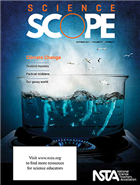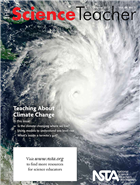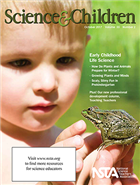Ideas and inspiration from NSTA’s October 2017 K-12 journals
By Mary Bigelow
Posted on 2017-10-19
Having just completed an online course on climate change, I was interested in the Commentary: Why the Scientific Consensus on Climate Change Matters for Science Education, from The Science Teacher, and the important role science teachers play in helping students understand this global issue.
The featured articles in Science Scope and The Science Teacher focus on climate change. Both journals have excellent ideas to help students understand the local relevance of this global issue, with lessons that could be adapted for different grade levels.
 Science Scope – Climate Change
Science Scope – Climate Change
From the Editor’s Desk: Tackling the Complex Issue of Climate Change: “…teaching climate change as if it were a debatable topic sends the message to students that it is acceptable to ignore scientific evidence and theories. The controversial nature of climate change is therefore exactly why we must teach it; to do so will help our students learn how to evaluate scientific information for the purpose of helping responsible citizens make informed consumer and voter decisions.”
Articles in this issue that describe lessons include a helpful sidebar (“At a Glance”) documenting the big idea, essential pre-knowledge, time, and cost. The lessons also include connections with the NGSS, and many follow a 5E format and include examples of student work and classroom materials.
- Empowering Sixth-Grade Students Through a Climate Change Lesson incorporates the question “Can a single human impact the planet’s climate?” with a 5E lesson on carbon footprints and mitigating climate change.
- Climate Change, Photosynthesis, and Misleading Information: Navigating Critical Thinking and Scientific Reasoning in the Classroom addresses whether plants benefit from increased levels of carbon dioxide in the atmosphere. [I also learned a new word in this article—”agnotology”—the study of misinformation.]
- Students assume the role of paleoclimatologists using proxy data to infer past climate conditions in Looking Backward, Looking Forward
- Using Packrat Midden Models to Investigate Climate Variability demonstrates the value of using “natural archives” to explore climate variability.
- Take your lesson on food webs to a new level with The Seabird Mystery Lesson: Integrating Science Inquiry and Science Literacy. The lesson takes a systemic look at the causes leading to a phenomenon affecting seabirds.
- A Gassy World: A Climate Change Investigation looks at the question “Will warming oceans be better or worse at absorbing carbon dioxide?”
- Integrating Technology: Lens on Climate Change: Using Place-Based Learning to Explore Climate Change Effects has suggestions for students creating videos about environmental changes in their own community. The article includes suggestions for adapting the activity to local communities.
- Scientists study bats as to see the effects of climate change on their food supply and echolocation abilities. The project described in Citizen Science: Be a Bat Detective! asks volunteers to classify bat calls available online. The author includes classroom suggestions.
- The 5E lesson in Disequilibrium: Measuring Our Rising Sea Levels models the effects of melting ice with a hands-on activity..
- Using greenhouses gases as a context, Teacher to Teacher: Vote, Discuss, Revote: A Formative Assessment Classroom Technique has an example of this technique and related resources.
These monthly columns continue to provide background knowledge and classroom ideas:
- Listserv Roundup: Growth Mindset in the Classroom
- Science For All: Self-Improvement Through Goal Setting
- Scope on the Skies: A Candle in Space
For more on the content that provides a context for projects and strategies described in this issue, see the SciLinks topics Bats, Carbon Cycle, Change in Climate, Ecosystems, Food Webs, Geologic Time Scale, Greenhouse Effect, Ice, Ocean Currents, Photosynthesis, Sea Level Change, Sonar, Wind Currents
Continue for The Science Teacher and Science & Children.
 The Science Teacher – Teaching About Climate Change
The Science Teacher – Teaching About Climate Change
Editor’s Corner: Hot Topic: “Climate change is one of the great moral imperatives of our time. Science teachers must provide students with the accurate knowledge that can inspire them to take action on a personal, community, and global level.”
The lessons described in the articles include connections with the NGSS and many include illustrations of student work.
- Is the Climate Changing Where We Live? has a 5E lesson and suggested resources for helping students see local effects of climate change.
- Even if you don’t live near the ocean, the ideas in Using Models to Understand Sea Level Rise illustrate the value of modeling in studying environmental phenomena.
- Modeling is also a feature of From Global to Local, using a socio-scientific approach to climate change.
- In the activity described in What’s Inside a Termite’s Gut?, students investigate the effects of environmental disruption on living things, among other topics.
- The authors of Science 2.0: Teaching the Facts About Climate Change suggest reputable websites with information about climate change.
These monthly columns continue to provide background knowledge and classroom ideas:
- Focus on Physics: The Ever-Present Atmospheric Pressure
- Career of the Month: Climate Scientist
- Right to the Source: Thomas Jefferson’s Observations on the American Climate
- How Quickly Do They React?
For more on the content that provides a context for projects and strategies described in this issue, see the SciLinks topics Atmospheric Pressure, Carbon Cycle, Climate Change, Ecosystem, Endosymbiosis, Homeostasis, Osmosis, Sea Level Change, Symbiosis
Science & Children – Early Childhood Life Science
 Editor’s Note: Revisiting the Framework: A Clear Pathway: “Of all the sciences, life science is probably the one that is most familiar and comfortable for early childhood educators. It is easily accessible to children and relatable—a good place to start using the tools of the Framework and NGSS.”
Editor’s Note: Revisiting the Framework: A Clear Pathway: “Of all the sciences, life science is probably the one that is most familiar and comfortable for early childhood educators. It is easily accessible to children and relatable—a good place to start using the tools of the Framework and NGSS.”
Children are naturally curious and enjoy learning and investigating. The Guest Editorial: How to Integrate STEM Into Early Childhood Education has the results of an examination of STEM environments for young learners and recommendations for educators and parents.
The lessons described in the articles have a chart showing connections with the NGSS and many includes illustrations of student work .
- There’s a Zoo in Our Room! illustrates how students created a replica of a zoo while applying a variety of scientific practices to learn about the characteristics of animals.
- The lessons in Scaly, Slimy Fun in Prekindergarten use local turtles and frogs in NGSS-aligned investigations. Students develop a greater understanding of animal adaptations behaviors.
- Teaching Through Trade Books: Animal Parents and Their Offspring has two 5E lessons: Raising Their Young (K-2) and Living in Groups (3-5).
- In addition to traditional plant growth investigations, Growing Plants and Minds has suggestions for incorporating digital tools in ways that are appropriate for younger students.
- Planting Deeper goes beyond listing the needs of plants to investigating plant growth, adaptations, and biodiversity in the outdoors.
- How Do Plants and Animals Prepare for Winter? has suggestions for designing inquiry-based 5E projects in an outdoor setting. The “wonder wall” is a variation of a traditional word wall.
- With the ideas in Early Years: What Other Colors Can Bean Seeds Be?, students learn about the needs of and variation in bean plants.
- Formative Assessment Probes: Uncovering Young Children’s Concept of a Plant
These monthly columns continue to provide background knowledge and classroom ideas:
- The Poetry of Science: Science in the Garden
- Science 101: How Do Amphibians Breathe?
- Engineering Encounters: The Paper Airplane Challenge
- Methods and Strategies: Formative Assessment Practices to Support Students who Struggle in Science
- Teaching Teachers: Inquiry in Inclusive Preschools
For more on the content that provides a context for projects and strategies described in this issue, see the SciLinks topics Adaptations of Animals, Amphibians, Characteristics of Living Things, Classification, Pollination, Reptiles, Seasons, Seed Germination, What Are the Parts of a Plant?
Disclaimer: The views expressed in this blog post are those of the author(s) and do not necessarily reflect the official position of the National Science Teaching Association (NSTA).


